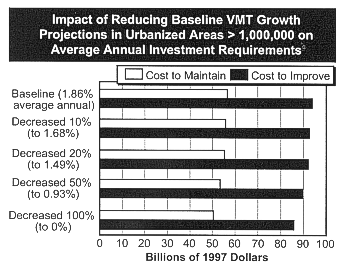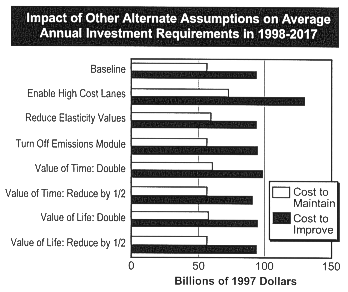U.S. Department of Transportation
Federal Highway Administration
1200 New Jersey Avenue, SE
Washington, DC 20590
202-366-4000
| |
| Conditions and Performance Report Executive Summary |
| Executive Summary Chapter Listing Conditions and Performance Home Page
|
|
The accuracy of the investment requirements in this report depends on the validity of the underlying assumptions used to develop the analysis. Changing these assumptions would reduce or increase the Cost to Maintain Highways and Bridges and the Cost to Improve Highways and Bridges. The HERS model assumes that the travel baseline forecasts for each highway section in the model represent not what future travel will be, but what it would be, if investment rose to the level required to keep highway user costs constant. If the State-supplied baseline HPMS projection of 2.16 percent average annual growth were increased to the 2.84 annual rate observed over the last 20 years, the Cost to Maintain and Cost to Improve Highways and Bridges would increase by 15.5 and 14.1 percent respectively. If the baseline HPMS projection for large urbanized areas were reduced by 10 percent (0.18 percentage points) from 1.86 percent to 1.68 percent, the Cost to Maintain and Cost to Improve would fall by 1.6 percent and 1.1 percent respectively. Reducing the large urbanized area baseline growth rate to zero would reduce the Cost to Maintain and Cost to Improve by 11.0 percent and 8.6 percent respectively.  |
 In previous reports, the HERS model was allowed to consider adding “high cost” lanes to a section, even if widening wouldn’t ordinarily be feasible. High cost lanes represent the cost required to double-deck a freeway, build a parallel route, or purchase expensive right-of-way. This feature was turned off for this report. Allowing HERS to consider high cost lanes would increase the Cost to Maintain and Cost to Improve by 28.7 percent and 38.0 percent respectively. The HERS travel demand elasticity values were increased in this report, and the HERS emissions module was turned on. Reducing the elasticity values to the levels used in the 1997 C&P report would increase the Cost to Maintain by 4.9 percent but reduce the Cost to Improve by 0.8 percent. Turning off the HERS emissions module would increase the Cost to Maintain and Cost to Improve by 0.1 percent and 1.1 percent respectively. Doubling the value of time or value of life in HERS would increase the Cost to Improve by 4.9 percent or 0.5 percent respectively. Cutting them by half would reduce the Cost to Improve by 3.8 percent or 0.2 percent respectively. |
|